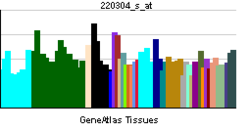- Cyclic nucleotide gated channel beta 3
-
Cyclic nucleotide gated channel beta 3 Identifiers Symbols CNGB3; ACHM3 External IDs OMIM: 605080 MGI: 1353562 HomoloGene: 40908 IUPHAR: CNGB3 GeneCards: CNGB3 Gene Gene Ontology Molecular function • nucleotide binding
• ion channel activity
• intracellular cGMP activated cation channel activity
• cGMP bindingCellular component • photoreceptor outer segment
• membrane
• integral to membraneBiological process • transport
• ion transport
• signal transduction
• visual perception
• response to stimulusSources: Amigo / QuickGO RNA expression pattern 
More reference expression data Orthologs Species Human Mouse Entrez 54714 30952 Ensembl ENSG00000170289 ENSMUSG00000056494 UniProt Q9NQW8 Q9JJZ9 RefSeq (mRNA) NM_019098 NM_013927.2 RefSeq (protein) NP_061971 NP_038955.1 Location (UCSC) Chr 8:
87.57 – 87.76 MbChr 4:
19.21 – 19.44 MbPubMed search [1] [2] Cyclic nucleotide gated channel beta 3, also known as CNGB3, is a human gene encoding an ion channel protein.[1]
Contents
See also
References
Further reading
- Hofmann F, Biel M, Kaupp UB (2006). "International Union of Pharmacology. LI. Nomenclature and structure-function relationships of cyclic nucleotide-regulated channels.". Pharmacol. Rev. 57 (4): 455–62. doi:10.1124/pr.57.4.8. PMID 16382102.
- Koenekoop RK, Lopez I, den Hollander AI, et al. (2007). "Genetic testing for retinal dystrophies and dysfunctions: benefits, dilemmas and solutions.". Clin. Experiment. Ophthalmol. 35 (5): 473–85. doi:10.1111/j.1442-9071.2007.01534.x. PMID 17651254.
- Pentao L, Lewis RA, Ledbetter DH, et al. (1992). "Maternal uniparental isodisomy of chromosome 14: association with autosomal recessive rod monochromacy.". Am. J. Hum. Genet. 50 (4): 690–9. PMC 1682625. PMID 1347967. http://www.pubmedcentral.nih.gov/articlerender.fcgi?tool=pmcentrez&artid=1682625.
- Winick JD, Blundell ML, Galke BL, et al. (1999). "Homozygosity mapping of the Achromatopsia locus in the Pingelapese.". Am. J. Hum. Genet. 64 (6): 1679–85. doi:10.1086/302423. PMC 1377911. PMID 10330355. http://www.pubmedcentral.nih.gov/articlerender.fcgi?tool=pmcentrez&artid=1377911.
- Sundin OH, Yang JM, Li Y, et al. (2000). "Genetic basis of total colourblindness among the Pingelapese islanders.". Nat. Genet. 25 (3): 289–93. doi:10.1038/77162. PMID 10888875.
- Kohl S, Baumann B, Broghammer M, et al. (2000). "Mutations in the CNGB3 gene encoding the beta-subunit of the cone photoreceptor cGMP-gated channel are responsible for achromatopsia (ACHM3) linked to chromosome 8q21.". Hum. Mol. Genet. 9 (14): 2107–16. doi:10.1093/hmg/9.14.2107. PMID 10958649.
- Peng C, Rich ED, Thor CA, Varnum MD (2003). "Functionally important calmodulin-binding sites in both NH2- and COOH-terminal regions of the cone photoreceptor cyclic nucleotide-gated channel CNGB3 subunit.". J. Biol. Chem. 278 (27): 24617–23. doi:10.1074/jbc.M301699200. PMID 12730238.
- Peng C, Rich ED, Varnum MD (2003). "Achromatopsia-associated mutation in the human cone photoreceptor cyclic nucleotide-gated channel CNGB3 subunit alters the ligand sensitivity and pore properties of heteromeric channels.". J. Biol. Chem. 278 (36): 34533–40. doi:10.1074/jbc.M305102200. PMID 12815043.
- Johnson S, Michaelides M, Aligianis IA, et al. (2004). "Achromatopsia caused by novel mutations in both CNGA3 and CNGB3.". J. Med. Genet. 41 (2): e20. doi:10.1136/jmg.2003.011437. PMC 1735666. PMID 14757870. http://www.pubmedcentral.nih.gov/articlerender.fcgi?tool=pmcentrez&artid=1735666.
- Peng C, Rich ED, Varnum MD (2004). "Subunit configuration of heteromeric cone cyclic nucleotide-gated channels.". Neuron 42 (3): 401–10. doi:10.1016/S0896-6273(04)00225-9. PMID 15134637.
- Michaelides M, Aligianis IA, Ainsworth JR, et al. (2004). "Progressive cone dystrophy associated with mutation in CNGB3.". Invest. Ophthalmol. Vis. Sci. 45 (6): 1975–82. doi:10.1167/iovs.03-0898. PMID 15161866.
- Okada A, Ueyama H, Toyoda F, et al. (2004). "Functional role of hCngb3 in regulation of human cone cng channel: effect of rod monochromacy-associated mutations in hCNGB3 on channel function.". Invest. Ophthalmol. Vis. Sci. 45 (7): 2324–32. doi:10.1167/iovs.03-1094. PMID 15223812.
- Kohl S, Varsanyi B, Antunes GA, et al. (2005). "CNGB3 mutations account for 50% of all cases with autosomal recessive achromatopsia.". Eur. J. Hum. Genet. 13 (3): 302–8. doi:10.1038/sj.ejhg.5201269. PMID 15657609.
- Nishiguchi KM, Sandberg MA, Gorji N, et al. (2006). "Cone cGMP-gated channel mutations and clinical findings in patients with achromatopsia, macular degeneration, and other hereditary cone diseases.". Hum. Mutat. 25 (3): 248–58. doi:10.1002/humu.20142. PMID 15712225.
- Varsányi B, Wissinger B, Kohl S, et al. (2006). "Clinical and genetic features of Hungarian achromatopsia patients.". Mol. Vis. 11: 996–1001. PMID 16319819.
- Bright SR, Brown TE, Varnum MD (2006). "Disease-associated mutations in CNGB3 produce gain of function alterations in cone cyclic nucleotide-gated channels.". Mol. Vis. 11: 1141–50. PMID 16379026.
- Bright SR, Rich ED, Varnum MD (2007). "Regulation of human cone cyclic nucleotide-gated channels by endogenous phospholipids and exogenously applied phosphatidylinositol 3,4,5-trisphosphate.". Mol. Pharmacol. 71 (1): 176–83. doi:10.1124/mol.106.026401. PMID 17018579.
- Wiszniewski W, Lewis RA, Lupski JR (2007). "Achromatopsia: the CNGB3 p.T383fsX mutation results from a founder effect and is responsible for the visual phenotype in the original report of uniparental disomy 14.". Hum. Genet. 121 (3-4): 433–9. doi:10.1007/s00439-006-0314-y. PMID 17265047.
External Links
- GeneReviews/NIH/NCBI/UW entry on Achromatopsia
- OMIM entries on Achromatopsia
- MeSH CNGB3+protein,+human
Na+: Sodium channel Constitutively activeProton gatedK+: Potassium channel Kvα1-6 (1.1, 1.2, 1.3, 1.4, 1.5, 1.6, 1.7, 1.8) · (2.1, 2.2) · (3.1, 3.2, 3.3, 3.4) · (4.1, 4.2, 4.3) · (5.1) · (6.1, 6.2, 6.3, 6.4)
Kvα7-12 (7.1, 7.2, 7.3, 7.4, 7.5) · (8.1, 8.2) · (9.1, 9.2, 9.3) · (10.1, 10.2) · (11.1/hERG, 11.2, 11.3) · (12.1, 12.2, 12.3)
Kvβ (1, 2, 3) · KCNIP (1, 2, 3, 4) · minK/ISK · minK/ISK-like · MiRP (1, 2, 3) · Shaker geneOther HVCN1GeneralCategories:- Human proteins
- Membrane protein stubs
- Ion channels
Wikimedia Foundation. 2010.
